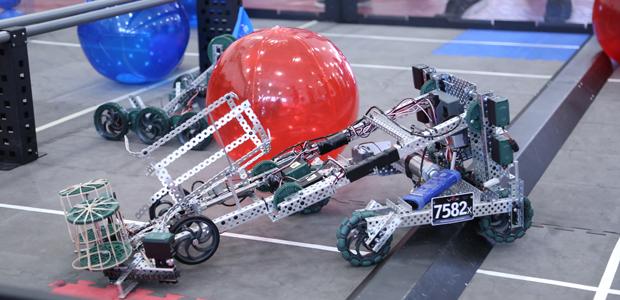Though not quite at the level of Real Steel or Wall-E, some of these robots built by students can serve functions in the medical field or even the Mars Rover mission. Mentors guide students as they build their own robots to compete in matches. Many of these students are the engineers of the future.
Feb. 22 marked the GCC Robotics club’s second year of hosting the VEX Robotics Competition for the middle and high school division. More than 7,300 teams from 25 countries play in 400 tournaments around the world. Every year tmembers face a new challenge.
Mentors guide students as they build their own robot to compete in matches. The club will compete for the first time at the college-level division,
VEX U, at Anaheim in March.
Student Chandler Brown, 18, came with her team representing J. Serra Catholic High School. Brown described hers as having a 3-joint arm and a hydraulic system to shoot bucky balls into the tubes. Her plan is to study engineering at Purdue University in Indiana.
“It’s a great social experience here, building while having fun,” said Brown
Brown had some advice for newcomers.
“Let every idea bloom. Don’t shut it down,” she said. “ It can actually become something.”
Among another group of students was Cameron Schiller, 14, who came by himself to compete with his robot. He got his funding from his parents, who gave him $2,000 for parts. Schiller described his robot as having a sturdy base, a 6-bar arm-lift that can do everything and a catapult that shoots balls, can hang above the ground, and can pick up both balls. It took him around eight months to complete, using C-based programming encoders on arms to make it easy to know where the arms are. The arm holds and pulls the robot a foot off the ground. His team ,Nrds Roc, will compete in the state competition in March.
Antony Magana, 14, Miraleste Robotics, from Palos Verdes.. Magana has experience with building several robots in three other competitions. He had some advice for building a good robot.
“Develop a creative mind, a large skill-set with building coding, and knowledge of gears,” said Magana.
Finishing in the semifinals, Magana cites playing with Legos as an influence in robot building, since they served as a creative outlet. He found out about the STEM program in sixth grade.
Standing next to Magana was 12-year-old Tanner Johnson, who was on a different team, 7035C, at the same school. Influenced by his woodshop teacher, his ship-builder father and also Legos, Johnson claimed to have done the majority of the building for his team. The student described his robot as having a scoop front that brings up balls big and small, and the arm shoots them.
“It may start out really hard but don’t stop,” he said about building robots. “It was really hard for me but I didn’t give up. I got to the semifinals. Don’t give up.”
Students in the GCC academy are currently working on the Capstone Project, a two-semester team project. They have built a robotic arm and are currently working on a mechanical 3D printer. The program gets its funding from the Title V grant, which will help buy extra parts and an actual competition field at GCC.
Money is also obtained through fundraisers like selling coffee and organizing a movie night.
Vivian Safarian and Tamara Talverdian, 20-year-old co-founders of the Robotics Academy, started as teacher’s assistants for the summer robotics academy, a two-week program that taught students programming,designing, and building robots.
“It’s cool to see kids who never had experience in the competition build amazing things,” Safarian said.
They both plan on getting a master’s degree, Talverdian in mechanical engineering management, and Safarian in electrical engineering.
After taking courses in engineering, the students revived the club through the assistance of professor Thomas Voden.


